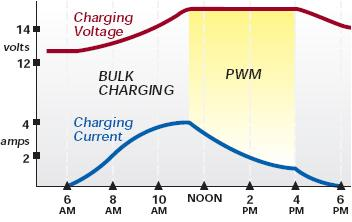Quite a few charge controls have a "PWM" mode. PWM stands for Pulse Width Modulation. PWM is often used as one method of float charging. Instead of a steady output from the controller, it sends out a series of short charging pulses to the battery - a very rapid "on-off" switch. The controller constantly checks the state of the battery to determine how fast to send pulses, and how long (wide) the pulses will be. In a fully charged battery with no load, it may just "tick" every few seconds and send a short pulse to the battery. In a discharged battery, the pulses would be very long and almost continuous, or the controller may go into "full on" mode. The controller checks the state of charge on the battery between pulses and adjusts itself each time.
PWM charging helps the battery to reach full charge by pulse charging, The PWM pulses slower, gradually tapering off the charge as the battery fills with amps. Pulsing is good for the batteries because it mixes the electrolyte cleaning the lead plates and preventing sulphation. This technology is used in most all charge controllers.

No comments:
Post a Comment